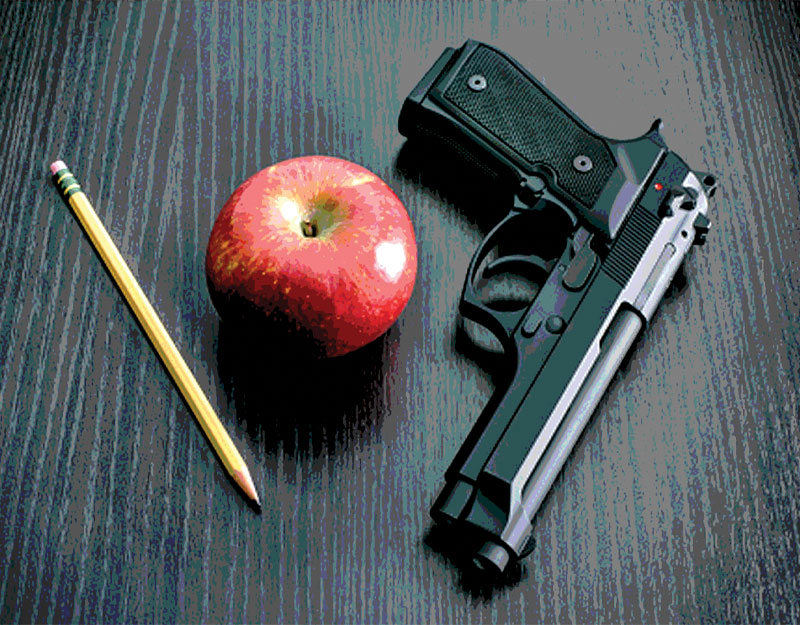New Ohio Law Clears Way for More Guns at School Amid National Debate Over Arming Educators
The Uvalde shooting reignited the debate to allow educators to carry weapons in school. The new law signed this week by Governor Mike DeWine makes educators and staff eligible to carry weapons on campus with much less training than previously required.
 |
|
Credit: kenlh/Getty Images |
After every school shooting, proposals for keeping schools safer emerge from educators, parents, and politicians. The recommendations frequently revolve around facility suggestions, procedural changes, mental health support, and, of course, guns. As part of these increasingly polarized discussions,
the debate over arming educators and staff reignites.
The days following the deaths of 19 students and two teachers at Robb Elementary School in Uvalde, TX, proved no different. The immediate aftermath brought not only the grief and questions, but proposals from some to add more guns to school campuses, while others fought to limit access to specific guns and increase regulation across the country.
In Ohio, Governor Mike DeWine took action that has the potential to put a mass of armed educators in classrooms when the 2022–23 school year begins. On Monday, DeWine signed a bill into law that would decrease the amount of training needed for employees to be armed in public school buildings and allow districts to decide if they would let educators and school staff carry weapons on school grounds. Deciding whether to allow armed educators onto school grounds will be up to each district.
While the Ohio bill was introduced before Uvalde was added to the long list of forever-traumatized towns that includes Oxford, MI; Newtown, CT; Parkland, FL; Littleton, CO; and more, DeWine invoked the most recent tragedy after signing the bill.
“That heartbreaking school shooting certainly increased the urgency to enact it,” he said during a press conference where he noted that the state is also focused on other school safety initiatives, including upgrading building security and helping staff identify behavioral problems in students.
The new law will lower the required training hours for armed school personnel from about 700 hours to four scenario-based training hours, plus a maximum of 20 hours for first-aid training, history of school shootings, and reunification education, according to The Columbus Dispatch. At a press conference, DeWine said he directed the Ohio School Safety Center to require at least 24 hours of training and eight years of requalification training each year.
“I honestly have mixed feelings,” says Barberton (OH) Middle and High Schools media specialist Joseph Vernacotola. “We have an SRO in our building and he is armed, obviously. One of my assistant principals is a part-time police officer. My principal is a retired Army officer, and we have a criminal justice program in our building led by a police officer. I think if their training is in law enforcement or military, I would be comfortable with them carrying a weapon in the building. I don’t think any teacher or administrator should be required to carry a weapon. I am all for doing what we need to do to protect students and staff. However, I would not want the average classroom teacher carrying a [firearm].”
More than half of U.S. states, including Ohio, already allow school staff to be armed on-site under certain qualifying conditions. And while the new law doesn’t make it mandatory for staff to carry weapons at school, it does make it easier by significantly decreasing the amount of training required.
The Ohio Educational Library Media Association did not respond to SLJ’s request for comment, but the Ohio Education Association, which represents more than 121,000 teachers in the state, released a statement from its president, Scott DiMauro, criticizing DeWine for signing the bill on the same day permitless concealed carry became legal in the state.
The Fraternal Order of Police of Ohio did not support the bill, with a representative testifying during the legislative debate that it would result in inadequately trained teachers and confusion about what exactly their role is during an active shooter situation—are they supposed to seek out a shooter or stay and protect their students?
According to Michael Anestis, executive director of the New Jersey Gun Violence Research Center, even well-trained armed officers don’t prevent mass shootings.
“I would not discount the value a school resource officer can provide in a lot of areas, but the evidence does not support that having armed guards prevents mass shootings,” Anestis said in a Q&A on the Rutgers University website. “In Uvalde, in the Dayton, OH, shooting in 2019, and in several other similar situations, heroic armed guards were present, and the shootings still took place.
“Our solutions need to involve better detecting and addressing risk for violence while kids are still in school, working to limit access to firearms that can fire ammunition at a rapid rate from a high-capacity magazine, and encouraging safe storage—and storage away from homes when somebody at home is in distress—of firearms.”
Beyond issues related to gun and ammunition access, Anestis noted the need for programs and policy that can identify a dangerous person and reduce the possibility that he can do harm.
“We need policies like extreme risk protection orders that can equip a community to reduce risk when they recognize that an individual is an imminent threat to themselves or others,” he said.
RELATED
The job outlook in 2030: Librarians will be in demand
The job outlook in 2030: Librarians will be in demand
ALREADY A SUBSCRIBER? LOG IN
We are currently offering this content for free. Sign up now to activate your personal profile, where you can save articles for future viewing





Add Comment :-
Be the first reader to comment.
Comment Policy:
Comment should not be empty !!!